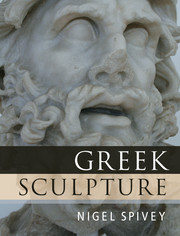Book contents
- Frontmatter
- Dedication
- Contents
- List Of Figures
- Preface
- Note
- 1 Introduction: the Study Of Greek Sculpture
- 2 The Greek Revolution
- 3 Daedalus and the Wings of Technê
- 4 Anathêmata: Gifts for the Gods
- 5 Heroes Apparent
- 6 Temple Stories
- 7 In Search of Pheidias
- 8 Revealing Aphrodite
- 9 Royal Patronage
- 10 Portraits and Personifications
- 11 Graecia Capta
- 12 Afterlife
- Index
Preface
Published online by Cambridge University Press: 01 December 2014
- Frontmatter
- Dedication
- Contents
- List Of Figures
- Preface
- Note
- 1 Introduction: the Study Of Greek Sculpture
- 2 The Greek Revolution
- 3 Daedalus and the Wings of Technê
- 4 Anathêmata: Gifts for the Gods
- 5 Heroes Apparent
- 6 Temple Stories
- 7 In Search of Pheidias
- 8 Revealing Aphrodite
- 9 Royal Patronage
- 10 Portraits and Personifications
- 11 Graecia Capta
- 12 Afterlife
- Index
Summary
This book is the offspring of another. Entitled Understanding Greek Sculpture, it was published in 1996 and went out of print several years ago. As any author would, I wished for a reissue – or rather, a second edition, correcting and updating where necessary. This wish developed into the more ambitious project of entire renovation. Motives were mixed: since I could not trace the ‘floppy disk’ where the words of the original text were stored, the book would have to be rewritten – but in any case I was glad of the opportunity to implement numerous pentimenti of style and substance, while adding several further chapters and extra material throughout.
The basic structure remains – along with the intention to provide an ‘understanding’ of Greek sculpture. In a fresh introductory section I have outlined the historic and aesthetic justification for studying this body of ancient art; here it may be worth adding a reminder that the ‘power of art’ is rarely self-sufficient. If artists of today require (as they seem to) critics and commentators to ‘explain’ their work, how much greater the need for glossaries on work produced 2,000 or more years ago? And naturally we create our own academic priorities for this as for any other field of study. Since 1996, there have been two distinct trends in research and writing about Classical art in general, and Greek sculpture in particular. The first has been to investigate ‘the viewer's share’ – to focus not so much on how images were produced as on how they were received. It remains rare to have any insight about the contemporary response to sculptures of the fifth century BC and earlier. Yet the exploration of later texts related to images and attention to the literary genre of ekphrasis – the descriptive ‘speaking-out’ of writers alluding to works of art, from Homer onwards – has become more sensitive and sophisticated; and there is even some fresh evidence (notably from papyrus remains of the thirdcentury BC poet Posidippus). An evolutionary and collective account of ancient response is still difficult to compose. This study, nonetheless, tries to maintain alertness to the religious power of images in their original function: a ‘theology of viewing’ wherever sculpture was once situated.
- Type
- Chapter
- Information
- Greek Sculpture , pp. xix - xxiPublisher: Cambridge University PressPrint publication year: 2013

